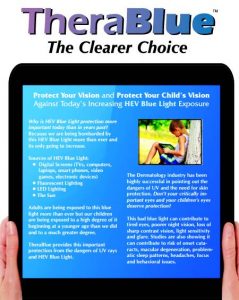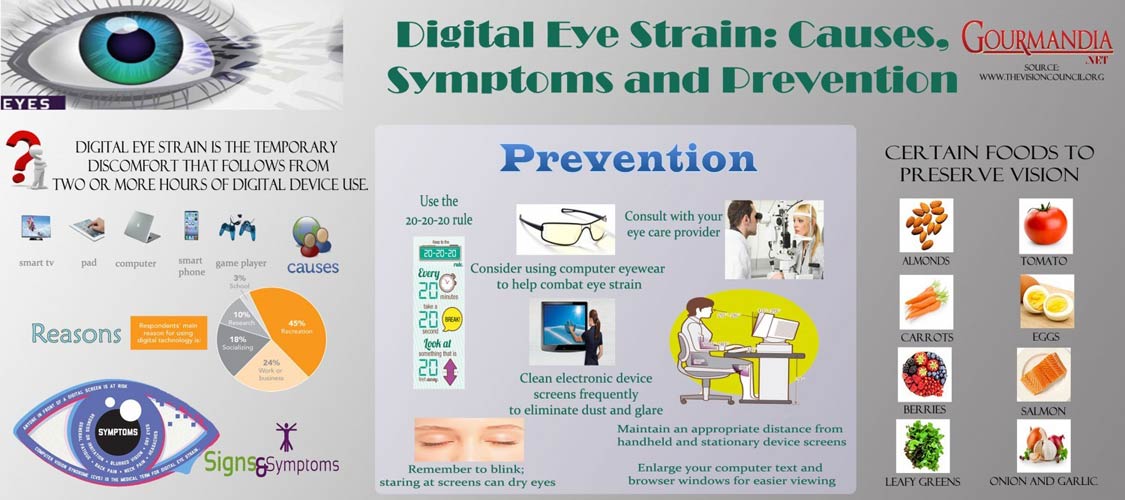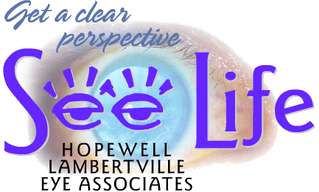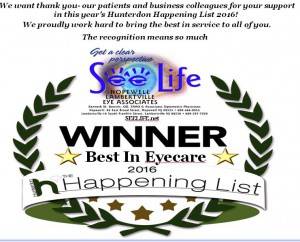By Marlon Lopez
Th ese days, many of us have jobs that require us to stare at computer screens for hours at a time. That can put a real strain on your eyes. Eye problems caused by computer use fall under the heading computer vision syndrome (CVS). It isn’t one specific problem. Instead, it includes a whole range of eye strain and pain. You are using your eyes everyday to perform various tasks that induce Digital Eye Strain.
ese days, many of us have jobs that require us to stare at computer screens for hours at a time. That can put a real strain on your eyes. Eye problems caused by computer use fall under the heading computer vision syndrome (CVS). It isn’t one specific problem. Instead, it includes a whole range of eye strain and pain. You are using your eyes everyday to perform various tasks that induce Digital Eye Strain.
Computer Vision Syndrome, also referred to as Digital Eye Strain, describes a group of eye and vision-related problems that result from prolonged computer, tablet, e-reader and cell phone use. Many individuals experience eye discomfort and vision problems when viewing digital screens for extended periods. The level of discomfort appears to increase with the amount of digital screen use. The average American worker spends seven hours a day on the computer either in the office or working from home. The more time spent – the more discomfort and symptoms.
How Does UV Light Affect Eyesight?
Both long- and short-term exposure to UV radiation, from both the sun and digital technology, can harm the eyes, affect vision, and compromise overall eye health. There are several eye diseases and conditions caused or aggravated by exposure to UV radiation, such as:
- Macular Degeneration. Macular Degeneration (AMD) is caused by damage to the retina over time and is the leading cause of age-related blindness. Extended exposure to UV light increases your risk of developing macular degeneration.
- Cataracts. A cataract is a clouding of the eye’s natural lens — the part of the eye that focuses the light we see. UV light, especially UV-B rays, increases your risk for certain types of cataracts. It is estimated that 10% of all cataract cases are directly attributable to UV exposure.
- Pterygium. Often called “surfer’s eye,” pterygium is a pink, non-cancerous growth that forms on the layer of conjunctiva over the white of your eye. UV light from the sun is believed to be a factor in the development of these growths.
- Skin Cancer.Skin cancer in and around the eyelids is also linked to prolonged UV exposure.
- Photokeratitis. Also known as corneal sunburn or “snow blindness,” photokeratitis is the result of high short-term exposure to UV-B rays. Long hours at the beach or skiing without proper eye protection can cause this problem. It can be very painful and may cause temporary vision loss.
What causes Computer Vision Syndrome or Digital Eye Strain?
 Viewing a computer or digital screen often makes the eyes work harder. As a result, the unique characteristics and high visual demands of computer and digital screen device viewing make many individuals susceptible to the development of vision-related symptoms.
Viewing a computer or digital screen often makes the eyes work harder. As a result, the unique characteristics and high visual demands of computer and digital screen device viewing make many individuals susceptible to the development of vision-related symptoms.
Uncorrected vision problems can increase the severity of Computer Vision Syndrome or Digital Eye Strain symptoms. Viewing a computer or digital screen is different than reading a printed page. Often the letters on the computer or handheld device are not as precise or sharply defined, the level of contrast of the letters to the background is reduced, and the presence of glare and reflections on the screen may make viewing difficult. Viewing distances and angles used for this type of work are also often different from those commonly used for other reading or writing tasks. As a result, the eye focusing and eye movement requirements for digital screen viewing can place additional demands on the visual system. In addition, the presence of even minor vision problems can often significantly affect comfort and performance at a computer or while using other digital screen devices. Uncorrected or under corrected vision problems can be major contributing factors to computer-related eyestrain.
Even people who have an eyeglass or contact lens prescription may find it’s not suitable for the specific viewing distances of their computer screen. Some people tilt their heads at odd angles because their glasses aren’t designed for looking at a computer. Or they bend toward the screen in order to see it clearly. Their postures can result in muscle spasms or pain in the neck, shoulder or back. In most cases, symptoms of CVS or Digital Eye Strain occur because the visual demands of the task exceed the visual abilities of the individual to comfortably perform them. At greatest risk for developing CVS or Digital Eye Strain are those persons who spend two or more continuous hours at a computer or using a digital screen device every day.
Digital Eye Strain
 With an increase in digital technology, many individuals suffer from physical discomfort after screen use for longer than two hours at a time. The Vision Council refers to this collection of symptoms as digital eye strain.
With an increase in digital technology, many individuals suffer from physical discomfort after screen use for longer than two hours at a time. The Vision Council refers to this collection of symptoms as digital eye strain.
More than 83 percent of Americans report using digital devices for more than two hours per day, and 53.1 percent report using two digital devices simultaneously, with 60.5 percent reporting experiencing symptoms of digital eye strain.
What is the impact?
Americans report experiencing the following symptoms of digital eye strain:
- 6 percent report experiencing eye strain
- 7 percent report experiencing dry eyes
- 4 percent report experiencing headache
- 22 percent report experiencing blurred vision
- 8 percent report experiencing neck and shoulder pain
Americans are becoming increasingly digitized, with more of our daily tasks moving online. For example:
- 6 percent use a computer to do research
- 6 percent use a smart phone as an alarm clock
- 2 percent use a computer to go shopping
- 7 percent use a smart phone to check the weather
- 7 percent use a computer to find a recipe
Digital eye strain is becoming a family affair, affecting all age groups. The following report using digital devices for more than two hours per day:
- 7 percent of those ages 18 to 39
- 6 percent of those ages 40 to 59
- 3 percent of those ages 60 and up
What can be done to alleviate digital eye strain?
 Eyewear is available with lenses featuring digital eye strain-reducing capabilities. However, individuals don’t have to sacrifice style for function when it comes to eyewear. These specialized lenses can be incorporated into virtually any pair of frames, so individuals can choose eyewear that complements their personal look, while meeting their eye health needs.
Eyewear is available with lenses featuring digital eye strain-reducing capabilities. However, individuals don’t have to sacrifice style for function when it comes to eyewear. These specialized lenses can be incorporated into virtually any pair of frames, so individuals can choose eyewear that complements their personal look, while meeting their eye health needs.
Many people are unaware of the solutions available to combat digital eye strain – in fact, 71 percent of Americans report they have not discussed their digital device usage with their eyecare provider, and 72.6 percent reported they did not know eyewear can be used to protect the eyes from short- and long-term effects of digital eye strain.
The Vision Council recommends individuals and their child(ren) visit a local eyecare provider to discuss their digital habits and what eyewear solutions are available to relieve the symptoms of digital eye strain.
In addition to eyewear solutions, other ways to relieve digital eye strain include:
- Following the 20-20-20 rule, taking a 20-second break from the screen every 20 minutes and looking at something 20 feet away
- Reducing overhead lighting to eliminate screen glare
- Positioning yourself at arm’s distance away from the screen for proper viewing distance when at a computer
- Increasing text size on devices to better define content on the screen
What is the impact on teens?
Teens today have grown up with technology always at their fingertips. Whether they’re playing the latest game or doing homework, technology permeates a teen’s life early on and increasingly becomes part of their daily routine as they get older.
In fact, 72 percent of Americans report their child(ren) / teen(s) – those under the age of 18 – gets more than two hours of screen time per day. And 30.1 percent report their child(ren)/teen(s) experiences one of the following after being exposed to more than two hours of screen time:
- Headaches
- Neck/shoulder pain
- Eye strain, dry or irritated eyes
- Reduced attention span
- Poor behavior
- Irritability
What can be done to alleviate digital eye strain?

Proper body positioning for computer use.
Eyewear is available with lenses featuring digital eye strain-reducing capabilities. However, individuals don’t have to sacrifice style for function when it comes to eyewear. These specialized lenses can be incorporated into virtually any pair of frames, so individuals can choose eyewear that complements their personal look, while meeting their eye health needs.
While 74.4 percent of parents are somewhat concerned about the impact of digital devices on their child(ren)/teen(s), only 24.6 percent report taking their child(ren)/teen(s) for an annual eye exam as part of back-to-school preparation.
The Vision Council recommends individuals and their child(ren) visit a local eyecare provider to discuss their digital habits and what eyewear solutions are available to relieve the symptoms of digital eye strain.
Blue Light
Blue light wavelengths are part of the electromagnetic visible spectrum. These waves emit energy, the shorter the wavelength, the higher the energy. It is this energy, over long periods of time that researchers have suggested we need adequate protection.
You know it as ultraviolet light, the wavelengths between 290nm and 380nm are (UVB/A) and 380nm to 500nm are (blue light). Because blue light has a very short wavelength, it produces a higher amount of energy than the other wavelengths of the visible spectrum. Some studies have shown that over time, exposure to the blue light could cause serious long-term damage to our eyes.
While we know that digital devices emit higher levels of blue light and we hold those devices close for long periods of time. We should consider managing exposure to blue light. We have some potential fixes: blue light attenuating lenses that can reduce blue light from screens by dimming the screen and of course, reducing screen time.
Sunlight has the most blue light exposure. We know not to look directly at the sun since even short periods of exposure can easily cause solar retinopathy due to high-intensity solar radiation. This means that we should wear blue light protection indoors and blue light and glare protection outdoors, to avoid discomfort and photochemical damage.
LEDs and Blue Light
LED’s (Light Emitting Diodes) have been a great innovation for office and home lighting as well as computer screens and monitors. This has allowed thinner, brighter, lighter, and much more energy efficient devices. The advantages of this technology has been a dramatic change in the lighting around us. But not everything is an advantage.
These lights are incorporated in different digital devices such as smartphones, PC’s and TV’s.
LED radiation has a downside to our health. Depending on the distance from our eyes to these light sources, and the frequency e.g., the time we spend in front of the screen and the average distance from our eyes to the screen of a computer (about 27 inches, to a tablet or about 21 inches) and a mobile screen that about 14 inches.
Light, For Vision and Non-Vision Functions
Did you know that the eye is the receptor for light that helps other natural functions for vision? In the list below we see that vision provides color and images but also for two eyes together, provides the opportunity for binocular vision. That allows 3 Dimensional vision with depth perception used for orientation. In addition, the contrast of colors, shades and shadows helps define edges and that adds to binocularity for adaptation and mobility. All of this is combined for complete visual acuity.
The ganglion cells of the retina are constructed to receive a variety of the longer blue wavelengths. With those, the body regulates sleep, mood, body temperature, heart rate and some hormone balance. Because of this, blue light has been used to treat seasonal affective disorder for some.
However, while we must allow blue light to provide the good blue wavelengths, we are concerned for those that can potentially damage the eye. So, a knowledge of both is in order.
Beneficial / Non-Beneficial Blue Light?
Blue light is everywhere, most exposure comes from sunlight. The shorter, high energy blue wavelengths collide with air molecules causing blue light to scatter which makes the sky appear blue. These wavelengths vibrate more easily than longer wavelengths. This kind of unsteady light produces glare that can diminish visual contrast and affect sharpness and clarity of vision. It contributes to eyestrain, headaches, physical and mental fatigue produced by many hours sitting in front of computer screen or other devices. This means that augmenting protection to our eyes’ natural filters can provide sufficient protection against blue light rays from the sun and electronic devices.
In its natural form our body uses blue light from the sun to regulate your natural sleep and wake cycles. This is known as your “circadian rhythm.” Blue light also helps to boost alertness, heighten reaction time, elevate mood, hormone production, and increase the feeling of well-being. Blue light therapy has been use with positive results in treating certain mood disorders.
Additionally, parents should encourage their child(ren)/teen(s) to take breaks when using digital devices; make sure child(ren)/teen(s) don’t put screens too close to their eyes, especially for long periods of time; and should ensure their child(ren)/teen(s)’ workspace is set up properly with a chair promoting correct posture with feet flat on the floor.
Some important factors in preventing or reducing the symptoms of CVS have to do with the computer and how it is used. This includes lighting conditions, chair comfort, location of reference materials, position of the monitor, and the use of rest breaks.
- Location of computer screen– Most people find it more comfortable to view a computer when the eyes are looking downward. Optimally, the computer screen should be 15 to 20 degrees below eye level (about 4 or 5 inches) as measured from the center of the screen and 20 to 28 inches from the eyes.
- Reference materials– These materials should be located above the keyboard and below the monitor. If this is not possible, a document holder can be used beside the monitor. The goal is to position the documents so you do not need to move your head to look from the document to the screen.
- Lighting– Position the computer screen to avoid glare, particularly from overhead lighting or windows. Use blinds or drapes on windows and replace the light bulbs in desk lamps with bulbs of lower wattage.
- Anti-glare screens– If there is no way to minimize glare from light sources, consider using a screen glare filter. These filters decrease the amount of light reflected from the screen.
- Seating position– Chairs should be comfortably padded and conform to the body. Chair height should be adjusted so your feet rest flat on the floor. If your chair has arms, they should be adjusted to provide arm support while you are typing. Your wrists shouldn’t rest on the keyboard when typing.
- Rest breaks– To prevent eyestrain, try to rest your eyes when using the computer for long periods. Rest your eyes for 15 minutes after two hours of continuous computer use. Also, for every 20 minutes of computer viewing, look into the distance for 20 seconds to allow your eyes a chance to refocus.
- Blinking– To minimize your chances of developing dry eye when using a computer, make an effort to blink frequently. Blinking keeps the front surface of your eye moist.
When Blue Light Strikes
Our eyes are designed specifically to process light and it’s difficult to think that over the course of a lifetime that light damages them. Here is the key thought: an “Excess” of high-energy light. Exposure to all types of visible and non-visible light happens continuously and it has a direct impact on our body and mind, some positive, some negative. It’s impossible to stop the transmission of light or to know which is the most valuable for our well-being. But, based on what we’ve learned, we can certainly filter what experts have learned as potentially damaging high-energy visible light and prevent it from harming us over a lifetime.
This article will emphasize the pros and cons of blue-violet and blue-turquoise light. That’s because as part of the digital age, it is important to know what we are exposed to when we use digital devices. Blue light has become a topic that professionals and media are talking about, mainly HEV light emitted from digital devices. Is this type of light dangerous? What are the risks?
Blue light, in its natural form, over a range of certainly wavelengths is necessary for many reasons: full color and photopic-vision, melatonin/serotonin regulation, body temperature, mood, etc.
The light that enters our eyes from the sun is essentially “white light”, equally composed of all the wavelengths that make up the colors we see. However, approximately 25% to 30% of white light is blue light. UV generally affects the front of the eye, blue light the retina though UVA and is problematic early in life when before the lens produces the chemicals needed to absorb UVA and UVB.
To better understand UV’s and its effects just know that the sun emits invisible ultraviolet radiation in the form of UVA, UVB and UVC rays. While UVC rays never penetrate the ozone layer, UVA and UVB rays do. UVA and UVB rays cause photo damage to the skin, leading to accelerated aging and an increased risk of skin cancers. The eyelid skin is the thinnest and most sensitive skin on your body. As a result, this is often the first area on your face to show change from sun damage and aging.
Exposure
The Lighting Research Center at Rennselaer Polytechnic Institute stated that, “…it takes an average of 13 hours in front of a computer screen to equal the amount of 15 minutes of sunlight blue lux. One hour of direct LED lighting equals to also 15 minutes of sunlight blue lux” Obviously, outdoors requires more protection but that suggests we teach patients the opportunities for outdoor and indoor eyewear. You might ask yourself, “What is your exposure and that of your customers?”
How many hours do you spend in front of a digital device?
 Most of us, in a normal day, spend more than 2 hours staring at a digital screen, whether it is work related or just for fun. Some studies stated that 60% to 70% of people spend more than eight hours a day in front of a digital device. With the potential for these devices to emit high-energy visible (HEV) blue light, which simply states that we all could benefit one way or the other from learning about protection.
Most of us, in a normal day, spend more than 2 hours staring at a digital screen, whether it is work related or just for fun. Some studies stated that 60% to 70% of people spend more than eight hours a day in front of a digital device. With the potential for these devices to emit high-energy visible (HEV) blue light, which simply states that we all could benefit one way or the other from learning about protection.
In fact, some schools are implementing a “Google Classroom”, a new way of learning. This means that, students will spend more time in front of the computer and digital devices. This gives us another reason to educate patients about the prevention of the accumulation and the importance of filtering HEV light. Since screen time is popular at even earlier ages, limiting screen time and/or protecting younger eyes is essential.
Protect Eyes from Blue Light?
Take precaution against the effects of blue light, whether out in the sunlight or indoors. Consider the products from different companies that have developed lens products designed to filter HEV and UV light. Visit websites that describe the opportunities for blue light attenuating lenses, some of which are listed here…TheraBlue Lenses (Luzerne Optical Laboratory), Crizal Prevencia No-Glare lenses by Essilor, HOYA Recharge, Zeiss DuraVision Blue Protect, Vision-Ease Clear Blue Filter, Transitions and BluTech Lenses available from a number of vendors. This new generation of lenses creates opportunities for the digital age.
Conclusion
Blue light, is necessary for our health and well being in the right wavelengths and amounts. Be aware of the visual and non-visual direct effects of blue light. An educated ECP and patient can achieve the best balance of prevention and protection.
Article References
1. Conrad, Karen S., Craig C. Manahan, and Brian R. Crane. “Photochemistry of Flavoprotein Light Sensors.” Nature Chemical Biology. U.S. National Library of Medicine, 10 Oct. 2014. Web. 07 Nov. 2016. (https://www.ncbi.nlm.nih.gov/pmc/articles/PMC4258882/)
2. Holzman, David C. “What’s in a Color? The Unique Human Health Effects of Blue Light.” Environmental Health Perspectives 118.1 (2010): n. pag. Web.
3. Dai, Tianhong, Asheesh Gupta, Clinton K. Murray, Mark S. Vrahas, George P. Tegos, and Michael R. Hamblin. “Blue Light for Infectious Diseases: Propionibacterium Acnes, Helicobacter Pylori, and Beyond?” Drug Resistance Updates 15.4 (2012): 223-36. Web.
 Marlon Lopez, ABO, NCLE Marlon is finishing an Ophthalmic Science Degree at Raritan Valley Community College and is an Optical Apprentice at Hopewell Lambertville Eye Associates. He has worked in the field for eight years and started his career with his CPO “Certified Para-Optometric” certification, New Jersey Society of Optometrists. He has enjoyed interacting recently with patients with a different perspective from studying lens types, anatomy of the eye, coatings and types of progressives.
Marlon Lopez, ABO, NCLE Marlon is finishing an Ophthalmic Science Degree at Raritan Valley Community College and is an Optical Apprentice at Hopewell Lambertville Eye Associates. He has worked in the field for eight years and started his career with his CPO “Certified Para-Optometric” certification, New Jersey Society of Optometrists. He has enjoyed interacting recently with patients with a different perspective from studying lens types, anatomy of the eye, coatings and types of progressives.
Read more
 UVA – Corrective Eyewear – Lenses
UVA – Corrective Eyewear – Lenses
TheraBlue, a new lens technology for protection from HEV (High Energy Visible) blue light.
Unlike some other blue light protection products, TheraBlue is an almost clear lens. It is not a coating and does not have a purple or blue reflective color, nor does it have a yellow, orange or peach color like some other products.
TheraBlue is available in single vision, progressive lenses, digital round bifocals and computer lenses. It is available in three different materials: 1.67, 1.60 and an impact-resistant 1.56. TheraBlue is compatible with a wide variety of anti-reflective coatings, and can be ordered with or without AR.
The UV and HEV blue light protection comes from the lens material itself. Instead of reflecting blue light, TheraBlue absorbs and filters the damaging HEV blue violet, while allow for the “good” blue turquoise light.
What is UV420?
 UV420 is a blue light that comes from artificial elements such as LCD Monitors, Smartphones and Tablets. UV light and other forms of high-energy light come not just from sunny skies, they also come at us from cloudy or rainy skies, and even in reflected light.
UV420 is a blue light that comes from artificial elements such as LCD Monitors, Smartphones and Tablets. UV light and other forms of high-energy light come not just from sunny skies, they also come at us from cloudy or rainy skies, and even in reflected light.
Short-term exposure to UV rays can cause photo-keratitis, which is sunburn of the eye. Over a long period, it can lead to cataracts. As for the light we can see, it is made up in part of high-energy visible light (HEV light), which is known to potentially cause Age-related Macular Degeneration (AMD) as we get older.
Benefits of UV420 Protection Lens
UV420 protection lens helps to shield your eyes from the harmful effects of the sun with a high level of broad-spectrum UVA and UVB protection
Benefits:
- Prevents UV aging the eyes
- Prevents UV damaging the eyes
- Protects against UV related eye disorders and diseases
In Summary:






